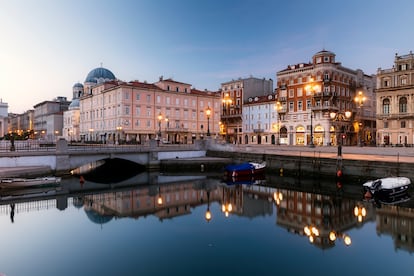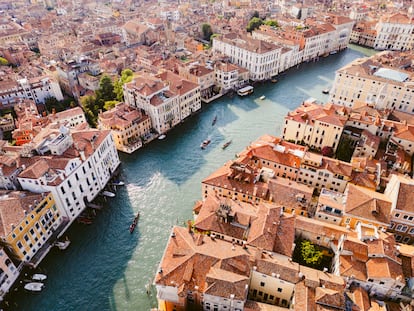As Predrag Matvejević says in Mediterranean breviarythe Adriatic before was called Venice Gulf. The long shadow of the Serenissima It extended to the italic boot, to the lands of another, widening a long trail of political and economic power, also aesthetic. “Venice is a fish. Check it on a map. It looks like a colossal sole lying in the back Venice is a fish. A guide.
LAs connections are also Central Europe, so Jorge Canals wrote The three venicies, The trivéneto of Trentino-Alto Adigio, Véneto and Venice Julia, as a political and artistic space Mittleuropeo.
Venice was always inspired. As Robert Kaplan wrote in Adriatic: “In the city a single word cannot be pronounced that is not an echo of something that has already been said.” Joseph Brodsky reached the literary cusp with Water brandas did Mary McCarthy in Venice observed.
There have been many authors passionate about a city that is able to get the senses, from Thomas Mann with the Death in Venice, Cees Nooteboom and Venice. The lion, city and water O Jan Morris and Venice. Some have also written about the ability of that place to instigate the lowest pleasures on the cloudy and venal waters, such as the American writer Donna Leon, through Commissioner Guido Brunetti.
Radoslav Petkovic, EN Destination and observations, It tells a trip in the direction of Pula, and passes near Trieste, as a place exposed to the sea, but removal between the surrounding mountains, while the train progresses slowly through the rails: “We must be close to trieste, I thought, looking down, to the valley; the other side was surrounded by low hills covered with stunted vegetation, and the sky made its way Caps, something shone powerfully. It is shocking how the European interior of black lands and humid forests becomes calcareous foals of dry pines and thickets.

Javier Reverte described the italic geography of the Adriatic in Italian suite: a trip through Venice, Trieste and Sicilybut from its reading it is inferred that the Adriatic Coast is a sea of cities. Each of them represents a cosmos in itself, sometimes dissociated from the state to which it belongs. This is the case of Trieste, probably the least Italian city of Italian cities and yet the most European and literary. The city of Caffé San Marcos, of the Caffè Degli Spechi or of Caffè Tommaeo happens to be the city of literary intimacy, where the creator meets an existential mirror, between the melancholy of the silence of its streets and the refined buildings. In the search for its identity, as stated by Scipio Slaper in I get stuffedhistorical cycles, the decline of time and the identity disorientation of an austro-hungarian imperialism and sea people, still present in the coexistence of Slovenian and Italian Istrian fishermen are reflected. His friend Giani Stuparich narrated him brilliantly in three Adriatic jewels: The island, A year of school in Trieste y War of 15where the reader cannot abstract from the anguish and coastal yearnings.
Probably, it was another triestino, Italo Svevo, who will be able to capture with more success in A life, Senescence y Zeno’s conscience The anxieties, contradictions and uncertainties of gray men through psychoanalytic exploration, miserable and vulnerable, shadows of low self -esteem, always emphasized between tradition and modernity, constant and apparently irresoluble problem. All that literary contribution, full of anti heroic paradoxs is unbridled by Claudio Magris and Angelo Ara in Triestean academic compendium in the history of the city, with the resource of the most distinguished literary testimonies. Magris more than a writer, or even an ambassador, has become the voice of triestine consciousness.
That city rises as an allegory of European and Europeanist culture even in the most tragic: Necropolis De Boris Pahor is an atrocious story of the Holocaust, in terms similar to the recently reissue Trieste de Dasa Drndić, y Green waterby Marisa Madieri, it is a elegy full of lyricism about the condition of the displaced, where children’s passages and family memories make up the world and our way of being in it. Both authors, linked by origins to the current Rijaka, the Italian Fiume, shows how under the clarity of the Mediterranean blue, too much spotted with blood stained. This is the moral that is inferred from The borderby Franco Vegliani, where the first and Second World War are merged into the rugged landscape of the Dalmatian Islands. It seems a lie that human foolishness arise with that virulence in these places.

Because the Adriatic Coast becomes a secarral, a hostile place where the karst It transforms into a desert of stone and dehydrated plants, beaten by the bora. There live the red characters created against Tomić, author of Miracle in the Víboras Valleya family of men, careless, but anxious to get out of the pedregals to find a wife. This is how Želimir peri concerns it in your story Greetings from Dalmia: After a holiday, an restless man is ravaged by a torrid and soulless weathering that announces his transit to death.
Another Dalmatian writer, from Zadar, Roman Simić Bodrožić, matures those ambivalent contexts in their collections of stories, in What we fell in love y Feed mewhere archeology and actuality, fatality and sun loungers can be compensated, to make adriatic literature an amphibious genre.
They are not clear what are the literary contours of the Adriatic, if they are in time or in space. Robert perišić in A cat at the end of the world He turns to an Adriatic Odyssey of the Ilias to address modern dilemmas, and Mirko Kovač in The city in the mirror Train by train to Dubrovnik in search of his father as if he were going to penetrate another spatial dimension.
The locals say that the limits of the Adriatic are there where the olive groves stop growing and the lavender fragrances disappear. The trip in transatlantic, the joy of crossing in ferry The more than 1200 Croatian Islands or simply reach a sea port with a book under the arm, for example, to Kotor’s bay. This is a good start or a good ending for an adventure novel.

